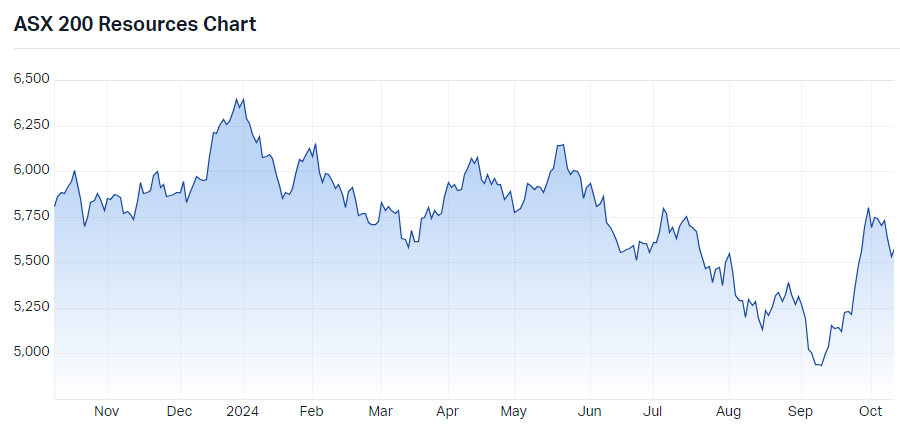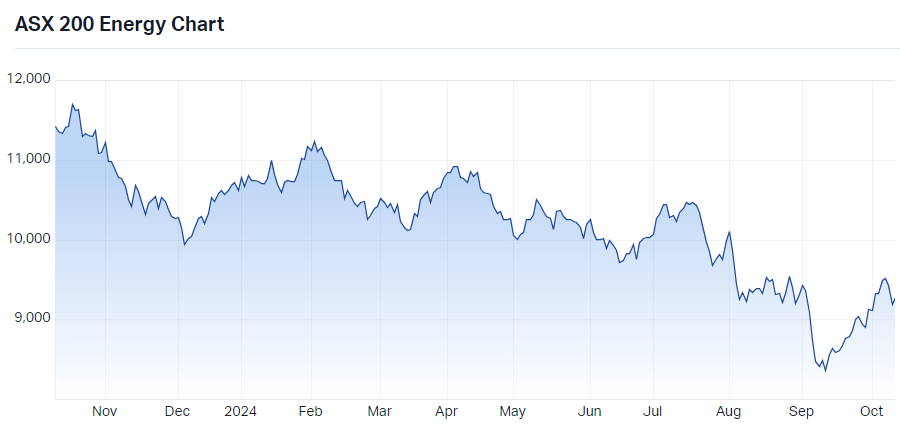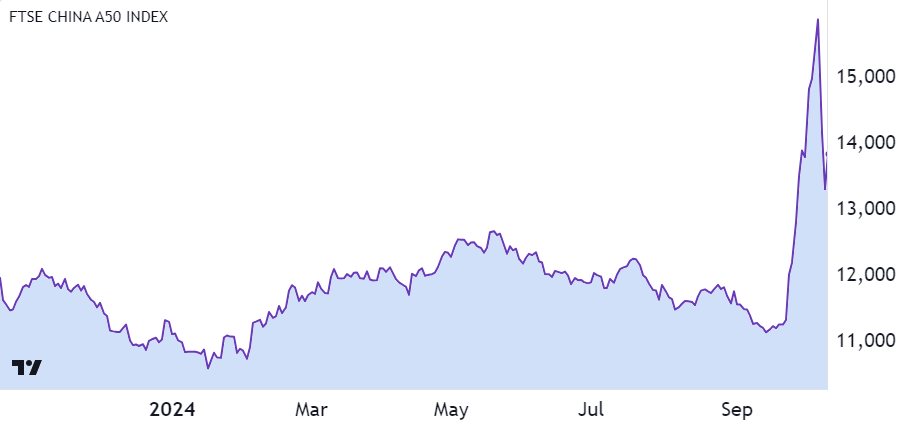ASX mining and energy stocks want more China stimulus, but when and how much is coming?
One of the biggest news events in markets this year was the coordinated announcement of several monetary policy measures from the PBOC and the promise of substantial fiscal measures to come from the People’s Bank of China and the Chinese government. The result so far has been the biggest rally in ASX mining and energy stocks since China scrapped its draconian zero COVID policy in late 2022.
Looking at the prices of the two major ASX mining and energy sector indices, the S&P/ASX 200 Resources (XJR) and the S&P/ASX 200 Energy (XEJ), it appears the initial euphoria over the September stimulus announcements is beginning to wear off a little. Both are sporting modest pullbacks from the % and % rallies each saw respectively since the September low.

S&P/ASX 200 Resources (XJR) chart Source: Market Index

Chinese stocks also surged on the news, rallying as much as 44% at one stage, but as can be seen from the chart below of the benchmark FTSE China A50 Shares index, have also corrected – and far more severely than local mining and energy stocks have so far.

There have been multiple false dawns in China-economy exposures in recent years. The question is, with China’s property market still in a downward spiral by all major metrics, and with the Chinese economy likely to slip below its target 5% GDP growth rate in 2024 according to several major brokers (Citi and Goldman Sachs are each forecasting 4.7%), should Aussie investors believe this time will be any different?
In this article, we investigate what stimulus measures might still be in the pipeline, and the impact these might have on the ASX mining and energy sectors.
How much stimulus is still to come?
This is the question Citi analysts attempt to answer in a research note published today titled “China Commodities: Great Expectations or Lost in Translation? Differentiated potential stimulus impacts on commodities”. In the note, Citi suggests that as much as RMB 3 trillion (A$630 billion) fiscal stimulus is on the way “within the year” with this amount to be roughly evenly distributed across the following:
- To offset revenue shortfalls at heavily indebted local governments;
- For growth initiatives to aimed at boosting consumption;
- To help recapitalise Chinese banks.
Citi notes the consequences if markets don’t see measures at least as big as this, “If fiscal follow-up were to come below market expectations, we believe investors would be disappointed, with likely further negative market reaction.”
Morgan Stanley’s views on what needs to be done to satisfy the market’s now bulging expectations is substantially greater. In a research note released yesterday titled “The Viewpoint: China: Why the Hesitancy to Enact Forceful Fiscal Easing?”, the broker suggests Beijing will have to stump up as much as RMB10 trillion (A$2.1 trillion) in order to support consumption and clear the country’s massive property inventory overhang.
Morgan Stanley warns that whilst this amount is likely the order of magnitude required to solve China’s economic problems, what will actually be delivered may only be a fraction of this. “But policy makers appear hesitant to enact forceful fiscal easing”, the broker notes, and ultimately the scale of the stimulus Beijing delivers will likely be “constrained by high public debt ratios and declining revenues”.

Morgan Stanley notes that the go-to playbook for Chinese policy markers for a generation now has been to invest in infrastructure and capacity, rather than in boosting consumption. This will probably continue, suggests the broker, unless “social dynamics weaken materially”. Without such a “trigger for forceful fiscal easing”, they conclude “We see limited fiscal measures in the near term”.
What is the likely timing of stimulus announcements?
There are two key upcoming events investors in ASX mining and energy stocks absolutely must watch out for now. The first is a speech planned by China’s Finance Minister Lan Fo’an on Saturday 12 October. In this speech, Lan is expected to outline Ministry of Finance (MoF) plans for "intensifying countercyclical adjustment of fiscal policy to promote high-quality economic development." Translation: very-maybe-likely he’ll announce the highly anticipated fiscal measures.
If that doesn’t happen, or if only moderate measures are announced on Saturday – well firstly, Monday’s ASX trade is going to be very interesting – but the next-most likely event major fiscal stimulus measures might be announced is at the National People's Congress (NPC) meeting of its Standing Committee at the end of this month.
What do the brokers think about commodity prices given Chinese stimulus scenarios?
In a “Metal Matters” research note released on Tuesday, Citi noted that it was “turning tactically bullish base metals and iron ore in the very near-term on China policy momentum”. The broker suggests the recent pullback in some commodity prices as stimulus fever had begun to subside, could turn out to be a “tactical buying opportunity”. Citi’s favourite two commodities in this respect are copper and iron ore.
On the subject of iron ore, Morgan Stanley has also recently turned bullish. In its research note titled “Iron Ore's Jolt Back to Life”, the broker notes “the latest stimulus strikes us as an important pivot for sentiment, at a time when demand is seasonally improving” before adding “the rally likely has further to run.”
ASX stocks to watch according to both brokers include:
- Mineral Resources (ASX: MIN) - Rating: OVERWEIGHT, Price Target: $55.50
- Whitehaven Coal - Rating: OVERWEIGHT, Price Target: $7.60
- BHP Group - Rating: OVERWEIGHT, Price Target: $46
- Rio Tinto (ASX: RIO) - Rating: OVERWEIGHT, Price Target: $135.50
- Nickel Industries (ASX: NIC) - Rating: OVERWEIGHT, Price Target: $1.00
- 29Metals (ASX: 29M) - Rating: OVERWEIGHT, Price Target $0.55
This article first appeared on Market Index on Thursday 10 October 2024.
5 topics
7 stocks mentioned

